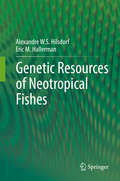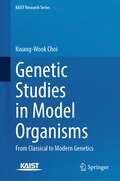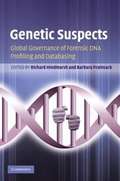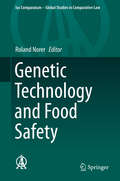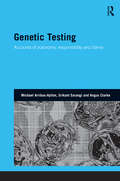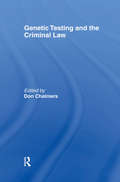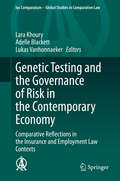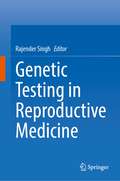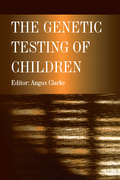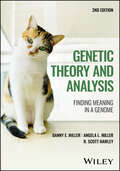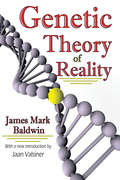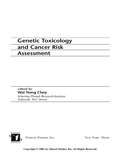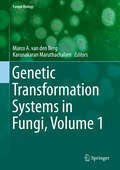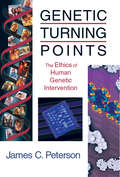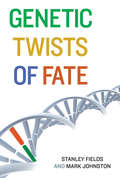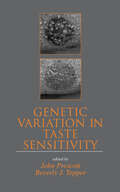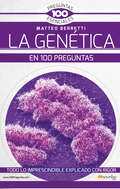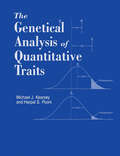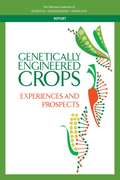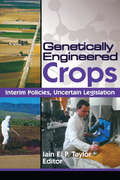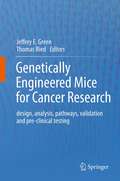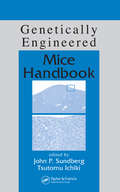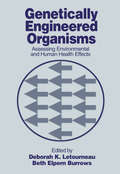- Table View
- List View
Genetic Resources of Neotropical Fishes
by Alexandre W. S. Hilsdorf Eric M. HallermanThe aim of this book is to systematize and discuss population genetic studies of freshwater fish in a region that harbors the greatest diversity of species among all inland water ecosystems. This volume explores the genetic evaluation for a number of orders, families and species of Neotropical fishes, and provides an overview on genetic resources and diversity and their relationships with fish domestication, breeding, and food production.
Genetic Studies in Model Organisms: From Classical to Modern Genetics (KAIST Research Series)
by Kwang-Wook ChoiThis book reviews key advances and new fundamentals in genetics. The increasing importance of genetic approaches in diverse areas of biology and medical sciences constantly requires in-depth information on genetic discoveries and research strategies for advanced graduate-level students as well as current researchers. This book focuses on genetic studies of various animal model systems and their major contributions to establishing modern genetics. Information covered in this book is mostly based on original research papers that extend from classical to modern genetics and applications. The contents are organized into four parts. Part I introduces fundamental concepts and experimental strategies in classical genetics. Part II discusses molecular genetics with transposons, transgenesis, clonal analysis, and gene editing technologies. Part III emphasizes epigenetic regulation of genome organization and gene expression. Part IV integrates earlier parts with landmark genetic studies on non-coding RNAs in dosage compensation, programmed cell death, growth control related to cancer, and behavioral neurobiology.
Genetic Suspects: Global Governance of Forensic DNA Profiling and Databasing
by Richard Hindmarsh Barbara PrainsackAs DNA forensic profiling and databasing become established as key technologies in the toolbox of the forensic sciences, their expanding use raises important issues that promise to touch everyone's lives. In an authoritative global investigation of a diverse range of countries, including those at the forefront of these technologies' development and use, this book identifies and provides critical reflection upon the many issues of privacy; distributive justice; DNA information system ownership; biosurveillance; function creep; the reliability of collection, storage and analysis of DNA profiles; the possibility of transferring medical DNA information to forensics databases; and democratic involvement and transparency in governance, an emergent key theme. This book is timely and significant in providing the essential background and discussion of the ethical, legal and societal dimensions for academics, practitioners, public interest and criminal justice organisations, and students of the life sciences, law, politics, and sociology.
Genetic Technology: A New Frontier
by Assessment Office Of TechnologyFirst published in 1982 . This report examines the application of classical and molecular genetic technologies to micro-organisms, plants, and animals. This book is one of the first comprehensive documents on emerging genetic technologies and their implications for society. The authors discuss the opportunities and problems involved, describe current techniques, and attempt to project some of the economic, environmental, and institutional impacts of those techniques. The issues they raise go beyond those of technology, utility, and economic feasibility. As we gain the ability to manipulate life, we must face basic questions of just what life means and how far we can reasonably-and safely-allow ourselves to go.
Genetic Technology and Food Safety
by Roland NorerThe volume gives an overview on how legislators all over the world have come up with different legal solutions for governing genetically modified organisms (GMOs) and food security and provides a compact summary of the existing regulations in this field. In a comparative legal approach, a general report analyses and compares these various national and supranational legal systems. It closely follows the newest developments at the interface between genetic engineering law and food law. The emergence of a new technology usually leads to fundamental questions as to how the law should respond to it. The regulation of genetically modified organisms is a prime example, they have been discussed controversially ever since they were subject of legislation and regulation. In particular, this applies to the use of GMOs in food production. There is a variety of interesting legislations and a differentiated width of legal frameworks on international, supranational (EU) and national level to be found. The different regulations that thereby came to light are evidence of the various opinions and policies the societies and states have developed on this matter. It is this variety of regulations the volume examines, primarily on the basis of national reports that were handed in concerning the topic of genetic technology and food security at the occasion of the XIX International Congress of Comparative Law.
Genetic Testing: Accounts of Autonomy, Responsibility and Blame (Genetics and Society)
by Srikant Sarangi Michael Arribas-Ayllon Angus ClarkeAdvances in molecular genetics have led to the increasing availability of genetic testing for a variety of inherited disorders. While this new knowledge presents many obvious health benefits to prospective individuals and their families it also raises complex ethical and moral dilemmas for families as well as genetic professionals. This book explores the ways in which genetic testing generates not only probabilities of potential futures, but also enjoys new forms of social, individual and professional responsibility. Concerns about confidentiality and informed consent involving children, the assessment of competence and maturity, the ability to engage in shared decision-making through acts of disclosure and choice, are just some of the issues that are examined in detail.
Genetic Testing and the Criminal Law
by Don ChalmersGenetic Testing and the Criminal Law is a unique international treatment of the dynamic and established criminal investigation technique of DNA testing. Gathering together expert practitioners, judges and researchers from twelve countries, each chapter deals with the specific criminal law of the jurisdiction in its interaction with the expanding use of DNA testing in criminal investigations and trials. The chapters cover the criminal law of the United Kingdom, Japan, Australia, Germany, New Zealand, Spain, South Africa, Canada, Italy, Finland, Argentina and Denmark, providing valuable accounts not only of the use of genetic testing in the criminal law, but also of the development of the law in these jurisdictions. No previous work has included such an extensive comparative study in this important area. Collectively, this book emphasizes the need for the law to respond to scientific developments thoughtfully and with a sensitive, well-reasoned approach to current concerns relating to the reliability of DNA evidence in criminal trials and the privacy and civil liberties issues surrounding the collection of DNA samples from individuals and their storage. This book is an invaluable reference for scholars, practitioners of criminal law and private international law, and students interested in this increasingly significant field of law.
Genetic Testing and the Governance of Risk in the Contemporary Economy: Comparative Reflections in the Insurance and Employment Law Contexts (Ius Comparatum - Global Studies in Comparative Law #34)
by Lara Khoury Adelle Blackett Lukas VanhonnaekerThis book addresses emerging questions concerning who should bear responsibility for shouldering risk, as well as the viability of existing and experimental governance mechanisms in connection with new technologies. Scholars from 14 jurisdictions unite their efforts in this edited collection to provide a comparative analysis of how various legal systems are tackling the challenges produced by the legal aspects of genetic testing in insurance and employment. They cover the diverse set of norms that surround this issue, and share insights into relevant international, regional and national incursions into the field. By doing so, the authors offer a basis for comparative reflection, including on whether transnational standard setting might be useful or necessary for the legal aspects of genetic testing as they relate to the insurance and employment contexts. The respective texts cover a broad range of topics, including the prevalence of genetic testing in the contexts of insurance and employment, and policy factors that might affect this prevalence, such as the design of national health or social insurance systems, of private insurance schemes or the availability of low-cost direct-to-consumer genetic testing. Further, the field of genetics is gaining in importance at the international and regional levels. Relevant concepts – mainly genetic tests and genetic data/information – have been internationally defined, and these definitions have influenced definitions adopted nationally. International law also recognizes a “special status” for human genetic data. The authors therefore also consider these definitions and the recognition of the special status of human genetic data within regional and national legal orders. They investigate the range of norms that specifically address the use of genetic testing in employment and insurance, encompassing international sources – including human rights norms – that may be binding or non-binding, as well national statutory, regulatory and soft-law mechanisms. Accordingly, some of the texts examine general frameworks relevant to genetic testing in each country, including those that stem from general anti-discrimination rules and norms protecting rights to autonomy, self-determination, confidentiality and privacy. In closing, the authors provide an overview of the efficiency of their respective legal regimes’ approaches – specific and generalist – to genetic testing or disclosure of genetic information in the employment or insurance contexts, including the effect of lack of legal guidance. In this regard, some of the authors highlight the need for transnational action in the field and make recommendation for future legal developments.
Genetic Testing in Reproductive Medicine
by Rajender SinghThis textbook illustrates the importance and significance of molecular genetic testing in reproductive disorders. The present book covers the genetic testing in various reproductive system anomalies, including disorders of sexual development, male infertility (Y deletions, autosomal mutations, sperm DNA fragmentation), female infertility (PCOS and POF), mitochondrial DNA testing for oocyte quality, recurrent pregnancy loss, pre-term birth, endometrial receptivity, prenatal genetic screening, reproductive carrier screening, preimplantation genetic screening, endometrial cancer, cervical cancer and other related reproductive health disorders. Microbiome testing and its contribution to genetic testing in reproductive medicine are also discussed. Genetic testing in some of these has already come into practice, genetic testing for others is established but not clinically practiced, and genetic testing for others is yet in infancy as there is only limited data available. For the disorderswhere sufficient genetic data to undertake genetic testing is not available, we have tried to put together the evidence for proposing such tests in the near future. Apart from this, the book also covers ethical, moral and technical challenges in genetic testing in reproductive medicine. The book aims to set up a standard with regard to genetic testing in the reproductive medicine field, encourage further data generation, and provide food for thought in the areas of lacunae. The book serves graduate students, researchers, clinicians, professors, and patients in the field of reproductive medicine.
The Genetic Testing of Children
by Angus ClarkeThis book, written by a leading geneticist, examines the ethical and social issues raised by the genetic testing of children. The opinions of geneticists, ethicists and affected families are all included to give a balanced view of this controversial field. Issues covered include confidentiality, potential abuses of genetic information (eg the use of test results by insurance companies) and the value of predictive genetic testing.The aim of the book is to improve awareness of the complexity of the issues raised and provide suggestions as to how the discussions must develop - it therefore raises new questions as well as answering those that already exist.
Genetic Theory and Analysis: Finding Meaning in a Genome
by Danny E. Miller Angela L. Miller R. Scott HawleyGENETIC THEORY AND ANALYSIS Understand and apply what drives change of characteristic genetic traits and heredity Genetics is the study of how traits are passed from parents to their offspring and how the variation in those traits affects the development and health of the organism. Investigating how these traits affect the organism involves a diverse set of approaches and tools, including genetic screens, DNA and RNA sequencing, mapping, and methods to understand the structure and function of proteins. Thus, there is a need for a textbook that provides a broad overview of these methods. Genetic Theory and Analysis meets this need by describing key approaches and methods in genetic analysis through a historical lens. Focusing on the five basic principles underlying the field—mutation, complementation, recombination, segregation, and regulation—it identifies the full suite of tests and methodologies available to the geneticist in an age of flourishing genetic and genomic research. This second edition of the text has been updated to reflect recent advances and increase accessibility to advanced undergraduate students. Genetic Theory and Analysis, 2nd edition readers will also find: Detailed treatment of subjects including mutagenesis, meiosis, complementation, suppression, and more Updated discussion of epistasis, mosaic analysis, RNAi, genome sequencing, and more Appendices discussing model organisms, genetic fine-structure analysis, and tetrad analysis Genetic Theory and Analysis is ideal for both graduate students and advanced undergraduates undertaking courses in genetics, genetic engineering, and computational biology.
Genetic Theory of Reality: Being The Outcome Of Genetic Logic - Scholar's Choice Edition
by Jaan Valsiner James Mark BaldwinJames Mark Baldwin left a legacy that has yet to be fully examined, one with profound implications for science and the humanities. In some sense it paralleled that of his friend Charles Sanders Peirce, whose semiotics became understood only a century later. Baldwin was trying to make sense of complex biological and social processes that only now have come into the limelight as biological sciences have re-emerged in psychology. Baldwin's focus on development, based on the observation of his own children and extrapolated to his general theoretical scheme, is fully in line with where contemporary biological sciences are heading. This is exemplified by the bounded flexibility of the work of the genetic system. The general principle of persistent exploration of the environment with the result of creating novelty, which was the core of Baldwin's theoretical system, has since the 1960s become the guiding idea in genetics. Contemporary developmental science is rooted in Baldwin's thinking. In his new introduction, Jaan Valsiner shows that Baldwin's Genetic Theory of Reality demonstrates how human beings are in their nature social beings, establishes an alternative conceptualization of evolutionary theory, and formulates a system of developmental logic, all of which serve as the foundation for developmental psychology as a whole. This is a work of social science rediscovery long overdue.
Genetic Toxicology and Cancer Risk Assessment
by Wai Nang ChoyPresents state-of-the-art regulatory cancer risk assessment models including a biologically based model for two-hit carcinogenesis and cell proliferation!This book comprehensively reviews the various roles of genetic toxicology in human cancer risk assessment conducted by United States and worldwide regulatory agencies-discussing hazard ide
Genetic Transformation Systems in Fungi, Volume 1
by Marco A. Berg Karunakaran MaruthachalamSeveral different transformation techniques have been developed over the years and readily shown to be decisive methods in fungal biotechnology. This book will cover the basics behind the most commonly used transformation methods, as well as associated tools and techniques. Each chapter will provide protocols along with examples used in laboratories worldwide. Not only will this text provide a detailed background on applications in industrial and pharmaceutical relevant microbes, but also the importance of fungal pathogens in agricultural production (Phytophthora and Botrytis) and mammalian infection (Penicillium marneffei and Candida). Genetic Transformation Systems in Fungi, Volume 1 provides in-depth coverage of how the transformation of DNA is used to understand the genetic basis behind these fungal traits.
Genetic Turning Points: The Ethics of Human Genetic Intervention (Critical Issues in Bioethics (CIB))
by James C. PetersonThis timely volume clearly lays out the central ethical questions raised by today's rapid advances in biotechnology. James Peterson sorts through the maze of clinical decisions occasioned by human genetic intervention, organizing the range of moral considerations that now face us and exploring their practical impact on individuals, families, and communities. / The ethical question are covered in the order of how soon the particular technologies that raise them are becoming available. This unique format allows readers to go directly to issues of particular interest. Peterson assumes no prior knowledge of genetics or ethics, making his work one of the most accessible discussions of bioethics available today.
Genetic Twists of Fate
by Stanley Fields Mark JohnstonHow tiny variations in our personal DNA can determine how we look, how we behave, how we get sick, and how we get well.News stories report almost daily on the remarkable progress scientists are making in unraveling the genetic basis of disease and behavior. Meanwhile, new technologies are rapidly reducing the cost of reading someone's personal DNA (all six billion letters of it). Within the next ten years, hospitals may present parents with their newborn's complete DNA code along with her footprints and APGAR score. In Genetic Twists of Fate, distinguished geneticists Stanley Fields and Mark Johnston help us make sense of the genetic revolution that is upon us.Fields and Johnston tell real life stories that hinge on the inheritance of one tiny change rather than another in an individual's DNA: a mother wrongly accused of poisoning her young son when the true killer was a genetic disorder; the screen siren who could no longer remember her lines because of Alzheimer's disease; and the president who was treated with rat poison to prevent another heart attack. In an engaging and accessible style, Fields and Johnston explain what our personal DNA code is, how a few differences in its long list of DNA letters makes each of us unique, and how that code influences our appearance, our behavior, and our risk for such common diseases as diabetes or cancer.
Genetic Variation in Taste Sensitivity
by John Prescott Beverly J. TepperFeaturing results presented at the Sensitivity to PROP (6-n-propylthiouracil) symposium held as a satellite to the European Chemosensory Research Organisation conference in Erlangen, Germany, this volume's field-shaping selections review all sides of PROP sensitivity measurement-from its descriptive worth with regard to sensory experiences, individual taste perceptions, and food choices to its predictive power in the nutrition and public health arenas. Written by recognized names from industry and academia, Genetic Variation in Taste Sensitivity is ideal for taste, olfaction, and flavor chemists and scientists; sensory evaluation chemists and scientists; and nutritionists.
La Genética en 100 preguntas (100 Preguntas esenciales)
by Matteo BerrettiLas respuestas de la ciencia a las cuestiones clave de la Genética: los organismos transgénicos, clones y mutaciones, la epigenética, la bioética, el papel de los genes en nuestras emociones, la estructura del ADN, la ingeniería genética y la medicina predictiva. ¿Cómo se construye un organismo desde el ADN?, ¿Se pueden crear mutantes?, ¿Cómo funciona el virus del SIDA?, ¿Qué es una dieta genética?, ¿Cómo se crea una planta transgénica?, ¿Para qué sirven los biochips?, ¿Existen los bebés a la carta?, ¿Existe el gen de la inmortalidad?, ¿Qué es la genética de poblaciones?, ¿Qué es un reloj molecular?
Genetical Analysis of Quantitative Traits
by Dr M Kearsey Dr H PooniThis text provides a guide to the experimental and analytical methodologies available to study quantitative traits, a review of the genetic control of quantitative traits, and a discussion of how this knowledge can be applied to breeding problems and evolution.
Genetically Engineered Crops: Experiences and Prospects
by Engineering Medicine National Academies of SciencesGenetically engineered (GE) crops were first introduced commercially in the 1990s. After two decades of production, some groups and individuals remain critical of the technology based on their concerns about possible adverse effects on human health, the environment, and ethical considerations. At the same time, others are concerned that the technology is not reaching its potential to improve human health and the environment because of stringent regulations and reduced public funding to develop products offering more benefits to society. While the debate about these and other questions related to the genetic engineering techniques of the first 20 years goes on, emerging genetic-engineering technologies are adding new complexities to the conversation. Genetically Engineered Crops builds on previous related Academies reports published between 1987 and 2010 by undertaking a retrospective examination of the purported positive and adverse effects of GE crops and to anticipate what emerging genetic-engineering technologies hold for the future. This report indicates where there are uncertainties about the economic, agronomic, health, safety, or other impacts of GE crops and food, and makes recommendations to fill gaps in safety assessments, increase regulatory clarity, and improve innovations in and access to GE technology.
Genetically Engineered Crops: Interim Policies, Uncertain Legislation
by Iain E. P. TaylorTake a closer look at the questions surrounding the long-term impact of GE cropsGenetically Engineered Crops examines current controversies surrounding the potential health, environmental, and social impacts of plants produced using molecular biology techniques. Educators, professionals, and practitioners representing a wide range of di
Genetically Engineered Mice for Cancer Research
by Jeffrey E. Green Thomas RiedGenetically-engineered mouse models for cancer research have become invaluable tools for studying cancer biology and evaluating novel therapeutic approaches. This volume focuses on state-of-the-art methods for generating, analyzing and validating such models for studying aspects of human cancer biology. Additionally, these models are emerging as important pre-clinical systems in which to test cancer prevention and therapeutic strategies in order to select compounds for testing in clinical trials.
Genetically Engineered Mice Handbook (Research Methods For Mutant Mice)
by John P. Sundbeg Tsutomu IchikiThis comprehensive book covers all aspects of the field of genetically engineered laboratory mice, including the creation of mutant mice through mouse models for developmental biology and the monitoring of laboratory mouse colonies. Written by leading biomedical investigators, pathologists, and clinicians, this book presents systematic approaches for analyzing mutant laboratory mice for specific medical applications. It provides a variety of methods for creating mutant mice, while covering legal aspects of mutant and inbred laboratory mice as well as the use and maintenance of international databases.
Genetically Engineered Organisms: Assessing Environmental and Human Health Effects
by Deborah K. Letourneau Beth Elpern BurrowsGenetic engineering suggests new avenues for constructing useful products, but it also poses hazards to the health of the environment and the public. Delineating those hazards is complicated, difficult, and important at every level of risk assessment and risk management decision-making. Risk assessment and risk management may be further complicated
